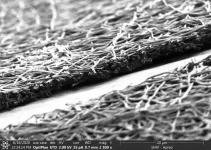(Press-News.org)
Lakmini Kidder, MBA, has been appointed to the newly expanded role of Senior Vice President, Finance, and Chief Revenue Officer (CRO) for Vanderbilt University Medical Center (VUMC). Kidder will begin her role on July 22. She joins VUMC from Johns Hopkins Health System in Baltimore, where she served as Vice President of Enterprise Revenue Cycle Management.
In her new capacity, Kidder will assume responsibility for overseeing all aspects of VUMC’s integrated revenue cycle, encompassing hospitals, clinics, the Vanderbilt Medical Group and Vanderbilt Integrated Providers. Additionally, she will oversee revenue management and reimbursement functions, including charge master management, pricing strategies and governmental reporting.
“The continued growth of our health system necessitates coordinated strategic leadership and broad expertise in revenue management functions. Lakmini was selected for this vital expanded role based on her extensive experience and background in revenue-related leadership and consulting roles in previous organizations,” said Cecelia B. Moore, MHA, CPA, VUMC’s Chief Financial Officer & Treasurer.
VUMC’s Office of Finance is comprised of three divisions and is responsible for a broad array of institutional functions including core financial services, revenue cycle operations and Supply Chain Services. The office, with more than 1,500 employees, oversees millions of financial transactions each year.
Kidder will serve as an advisor to the leadership team on matters concerning revenue cycle management, reimbursement and strategic revenue cycle operations. She will also play a pivotal role within the VUMC Finance team, driving integration and transformation throughout revenue management processes to enhance efficiency, decrease denials, accelerate cash collections, increase reimbursement, ensure compliance, and implement advanced technologies.
During her tenure at Johns Hopkins Kidder demonstrated exceptional leadership in revenue cycle management and organizational transformation, overseeing system-level alignment and scaling revenue operations in shared service areas to support growth. She integrated leading technologies to enhance patient-facing and revenue cycle functions, resulting in improvements in revenue performance and experience. Prior to her service at Johns Hopkins, Kidder served as Senior Director of Revenue Cycle Services for Regions Hospital and HealthPartners in St. Paul, Minnesota, where she led her team to receive the “MAP” award from the Healthcare Financial Management Association (HFMA) for outstanding achievements in pursuing revenue cycle excellence. She also served as a consultant for Ernst and Young in their management, risk and advisory practice.
Kidder holds a Bachelor of Arts in Economics from Earlham College and a Master of Business Administration from the Massachusetts Institute of Technology.
About her new role, Kidder said, “I am deeply humbled to join Vanderbilt University Medical Center, an institution renowned for its commitment to excellence in teaching, research and patient care. With a rich history and contemporary environment, Vanderbilt presents an exciting opportunity for collaboration and innovation. I am eager to work with our talented teams and harness the power of technology to further enhance the patient experience and provide unwavering support to VUMC’s dedicated physicians and care teams. Together, we will continue to prioritize patient-friendly solutions and innovative approaches to health care revenue cycle management, ensuring that VUMC remains a beacon of compassionate care and clinical excellence.”
END
Lakmini Kidder named Senior Vice President of Finance and Chief Revenue Officer
2024-06-06
ELSE PRESS RELEASES FROM THIS DATE:
Discovery highlights ‘critical oversight’ in perceived security of wireless networks
2024-06-06
A research team led by Rice University’s Edward Knightly has uncovered an eavesdropping security vulnerability in high-frequency and high-speed wireless backhaul links, widely employed in critical applications such as 5G wireless cell phone signals and low-latency financial trading on Wall Street.
Contrary to the common belief that these links are inherently secure due to their elevated positioning and highly directive millimeter-wave and sub-terahertz “pencil-beams,” the team exposed a novel method of interception using a ...
Diagnosing damaged infrastructure from space
2024-06-06
As infrastructure ages, it becomes more susceptible to failure, which can cause safety and mobility concerns for drivers and pedestrians, and economic woes for taxpayers. A recent study published in “Transportation Research Record” shows that high-resolution synthetic aperture radar (SAR) satellite data can detect infrastructure issues early on, which can help prevent further damage to roads in the same way that annual checkups can help prevent more complex health issues in humans.
Led by Dr. Anand Puppala and Ph.D. candidate Amit Gajurel, researchers at Texas A&M University are working on a new method of infrastructure monitoring using Synthetic ...
Plenary speakers and key deadlines announced for ISSCR 2025 annual meeting in Hong Kong
2024-06-06
The International Society for Stem Cell Research (ISSCR) convenes world-renown scientists dedicated to stem cell research and regenerative medicine each year at its annual meeting to share the year’s most compelling basic discoveries and clinical breakthroughs in the stem cell field. Abstract submission and registration for ISSCR 2025, taking place 11-14 June 2025, will open on 2 October 2024. Abstracts submitted by 21 January 2025 will be considered for oral presentations and merit and travels awards.
The ISSCR is proud to announce the ...
UTEP pharmacy researchers develop potential treatment for fibrosis
2024-06-06
EL PASO, Texas (June 6, 2024) — Researchers at The University of Texas at El Paso are developing a new therapeutic approach that uses nanoparticles for the treatment of skin and lung fibrosis, conditions that can result in severe damage to the body’s tissues.
Md Nurunnabi, Ph.D., is an associate professor in UTEP’s School of Pharmacy and the lead researcher on two studies published this June in the medical Journal of Controlled Release; one study focuses on skin fibrosis and the other on lung fibrosis.
“We are closer than ever ...
Employers coast to coast join movement to turn bystanders into lifesavers
2024-06-06
DALLAS, June 5, 2024 — Nine out of 10 people who suffer cardiac arrest outside of the hospital die, and cardiopulmonary resuscitation (CPR), especially if performed immediately, can double or triple survival rates.[1] That is why the American Heart Association, celebrating 100 years of lifesaving service, will broaden efforts to drive CPR education at the community level through the Heart Walk® campaign. Heart Walk is the Association’s largest community-based activation engaging more than 220 cities ...
Flavor restrictions affect tobacco buyers differently depending on socioeconomic status, researchers say
2024-06-06
Restricting menthol flavor in cigarettes while making nicotine replacement therapy, such as a skin patch that can help ease withdrawal, more available and affordable has the potential to reduce socioeconomic disparities in tobacco use.
That was one of the findings in a study published in May in Nicotine and Tobacco Research that marks a new use of existing data from the Fralin Biomedical Research Institute at VTC’s Addiction Recovery Research Center. Researchers analyzed data from their Experimental Tobacco ...
Botanists and archaeologists receive National Science Foundation grant to study Mediterranean history
2024-06-06
It’s an unusual collaboration. Botanists and archaeologists don’t often work together, unless they’re studying the way people have used plants through time. But a new four-year grant from the National Science Foundation is shaking things up. It provides more than $1 million to study how Mediterranean plants that people have largely ignored evolved and diversified in one of the most formative periods of human history.
“The Mediterranean is at the crossroads of Europe,” said Nicolas Gauthier, curator ...
Silkworms help grow better organ-like tissues in labs
2024-06-06
DURHAM, N.C. -- Biomedical engineers at Duke University have developed a silk-based, ultrathin membrane that can be used in organ-on-a-chip models to better mimic the natural environment of cells and tissues within the body. When used in a kidney organ-on-a-chip platform, the membrane helped tissues grow to recreate the functionality of both healthy and diseased kidneys.
By allowing the cells to grow closer together, this new membrane helps researchers to better control the growth and function of the key cells and tissues of any organ, enabling them to more accurately model a wide range of diseases and test therapeutics.
The research appears June 4 in the journal Science Advances.
Often ...
Scientists ‘read’ the messages in chemical clues left by coral reef inhabitants
2024-06-06
What species live in this coral reef, and are they healthy? Chemical clues emitted by marine organisms might hold that information. But in underwater environments, invisible compounds create a complex “soup” that is hard for scientists to decipher. Now, researchers in ACS’ Journal of Proteome Research have demonstrated a way to extract and identify these indicator compounds in seawater. They found metabolites previously undetected on reefs, including three that may represent different reef organisms.
Plants and animals living in coral reefs release various substances, from complex macromolecules to individual amino acids, into the surrounding water. To determine ...
Identifying risk factors for native coronary atherosclerosis progression after percutaneous coronary intervention
2024-06-06
https://www.scienceopen.com/hosted-document?doi=10.15212/CVIA.2024.0033
Announcing a new article publication for Cardiovascular Innovations and Applications journal. This study was aimed at investigating factors influencing the progression of native coronary atherosclerosis after percutaneous coronary intervention (PCI).
A cohort of 462 patients was classified into progressive (n = 73) or non-progressive (n = 389) groups according to the presence of native coronary atherosclerosis progression on coronary angiography. ...








